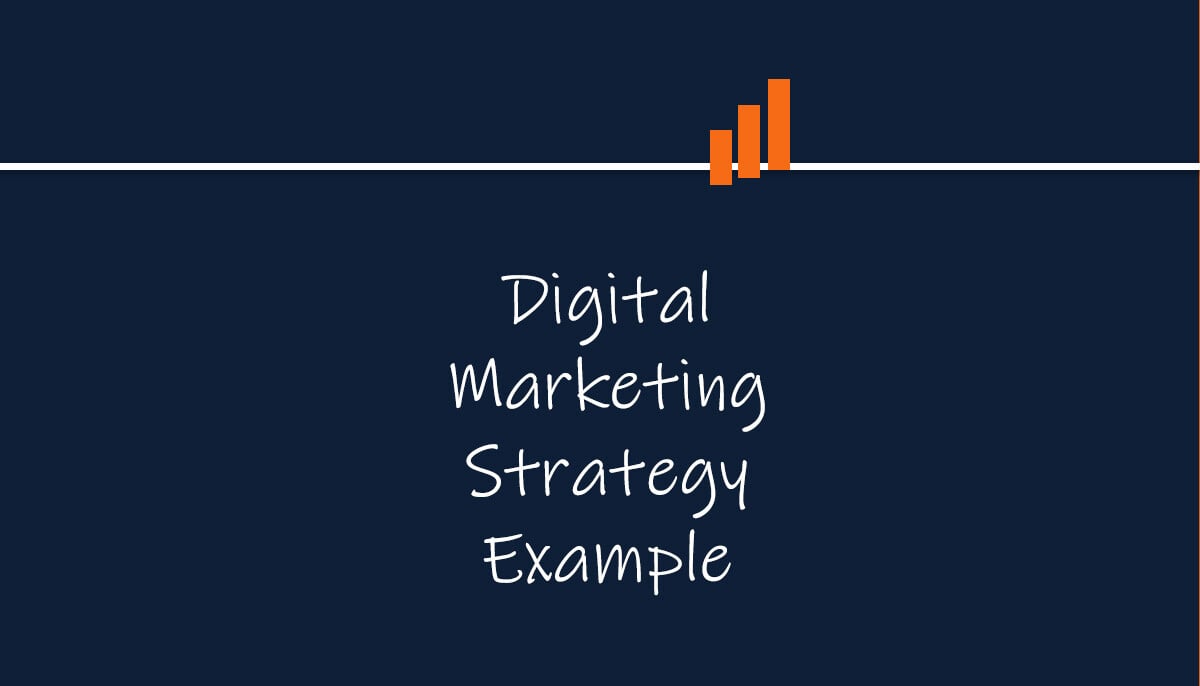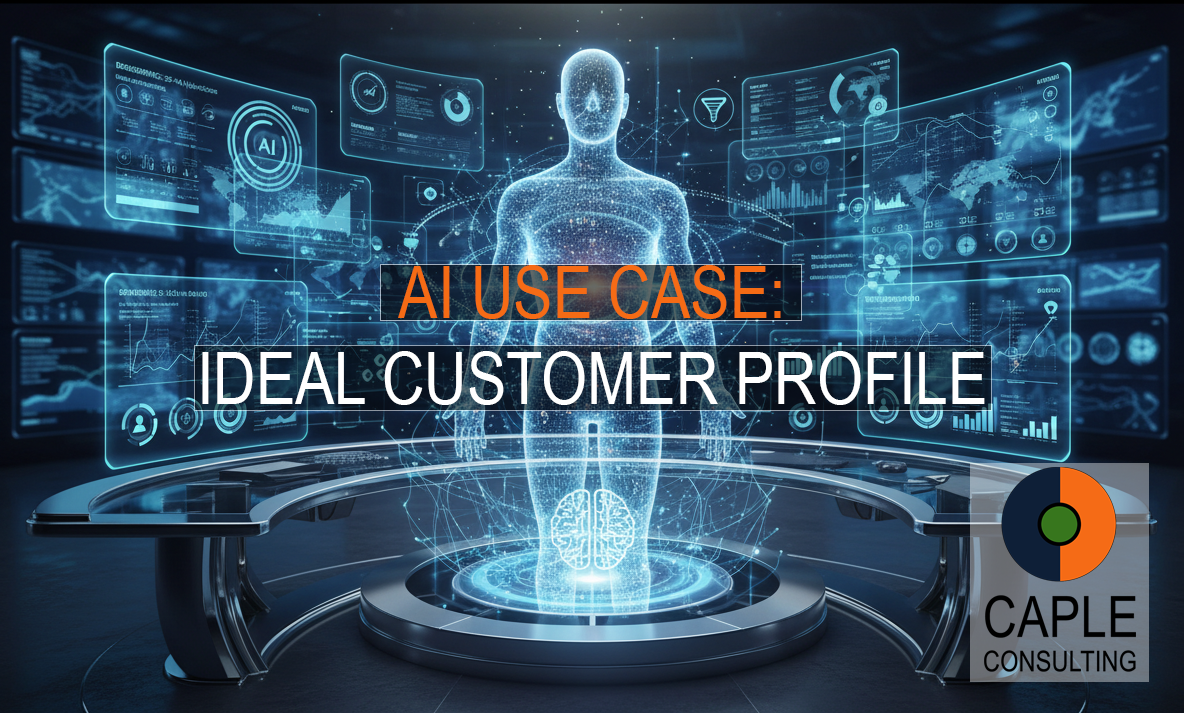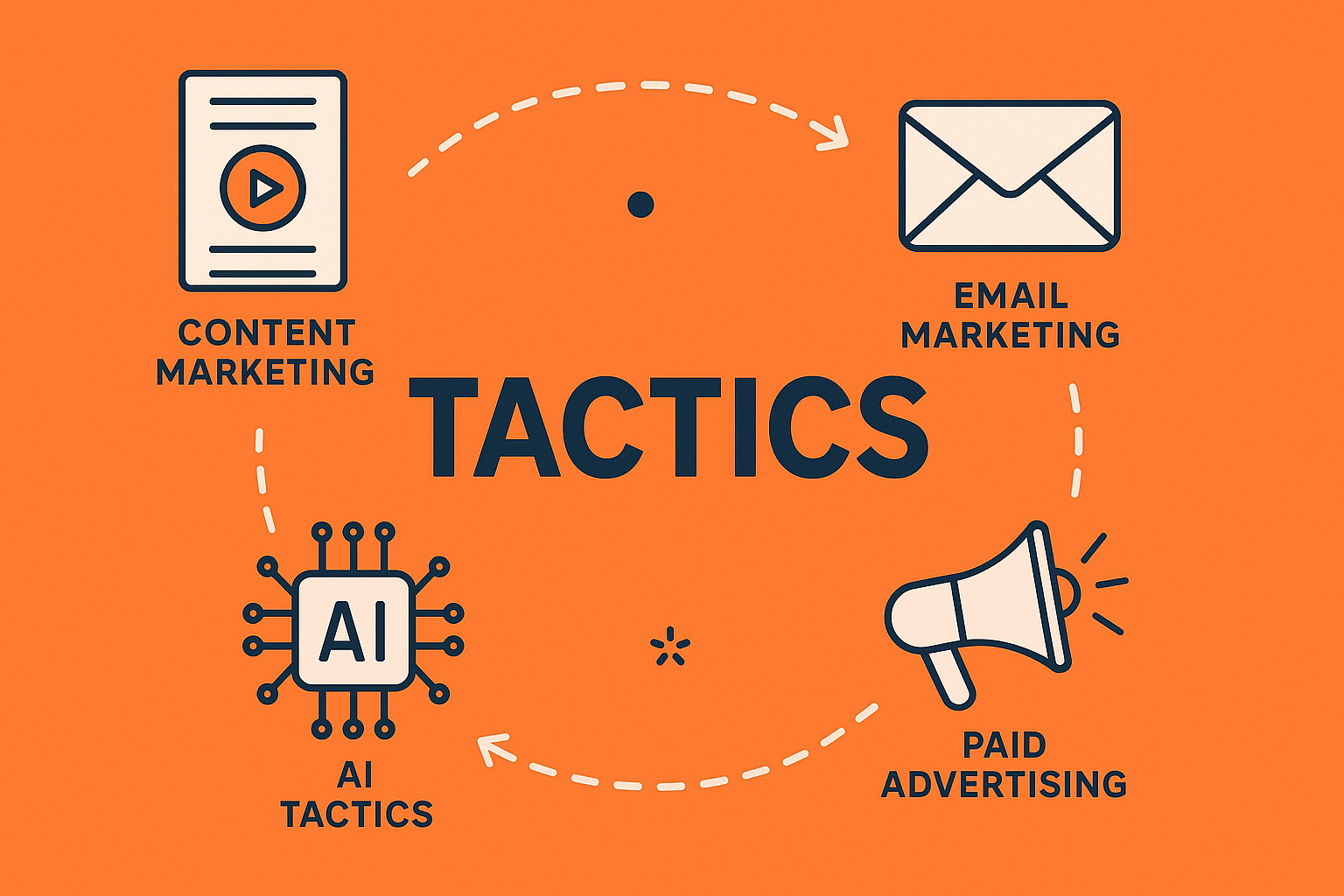Create ICPs with deeper insights for more personalised marketing using AI. Personalised marketing...
Digital Marketing Strategy Example

If you’re reading this then you are probably looking for an example to help create or update a digital marketing strategy. Great news, you are already ahead of some of your competitors, it’s all too easy to stick with what you know or what you have been doing but by taking the time to build or review a strategy will help you maximise your efforts and results.
In this article I’m setting out an example of how I create a strategy using a 10-point Framework that I have developed and touch on some widely adopted methods to give an all-round perspective.
Why do I need a strategy?
Maybe your business is doing just fine with some Google Ads and regular blogs, that’s your plan and it works. That’s ok, until it’s not.
Even a basic strategy provides direction, clarity and some accountability for what you are doing and enables you to track and measure success, taking learning points along the way so you can make improvements and become more efficient and productive.
A detailed and more comprehensive strategy gives you the edge over your competitors with a deeper understanding of why you are doing what you do and how that aligns with the overall business goals, priorities and purpose. It allows you to prepare properly by considering resources and budget while enabling decisions to be made with clear reasoning.
You need a strategy to know that you and the team are all pushing in the same (agreed) direction.
MasterPlan | 10 Point Strategy Framework
This is not a step-by-step process as each point can influence another and prompt amendments and refinements along the way.
Download The Strategy MasterPlan Framework PDF
This is a B2B Example with some sample detail, bullet points of what to cover and guide notes to help use this framework for your strategy development.

1. Objectives
If you ask the question “What are the objectives?”, it’s more than just sell more stuff, that’s obvious right. It’s the starting point, setting out what you want to achieve through your marketing activity and defining a clear purpose.
Here is what to cover when setting your objectives:
- Ask why, what is the reason for this strategy? To unite a team around a product launch; To increase sales across all products or; To raise brand awareness.
- Set Goals, and make them SMART. Make sure somebody is accountable for the goals so they can track and feedback.
- Desired outcome, what does success look like? Compose a concise statement that conveys the vision of success for your strategy.
- Identify priorities at the outset so your strategy can be laser focussed when it comes to implementation.
(Example Objectives)
- Why: Our widget maker is successfully sold into the food and beverage industry but there is an opportunity to expand into the health care sector.
- SMART Goals: (Specific, Measurable, Achievable, Relevant, and Time-Based)
- Increase prospect list to include 50 health care organisations in the UK that have an annual turnover of more than £5,000,000 by then end of Q2.
- Generate 5 sales opportunities for widget makers from the health care prospect list by the end of Q3
- Win 2 new clients from the health care sector purchasing widget makers by the end of Q4
- Desired Outcome: To break into the health care sector with sales of our widget maker that stimulating business growth.
- Priorities:
- Brand awareness within the health care sector
- Widget maker sales
- Case study for widget maker in health care sector
(End Example)
2. Value Proposition
A value proposition is a concise statement that communicates the core benefit that a product or service offers to customers. Essentially, it's an explanation of why a customer should choose you over your competitors.
Here's a breakdown of key elements that make a strong value proposition:
- Focuses on Customer Needs: A successful value proposition starts by understanding your target customer's pain points, desires, and motivations. What problems do they face? What are their goals?
- Highlights Key Benefits: Clearly communicate the key benefits your product or service offers that address your customer's needs. How does your offering make their life easier, better, or more successful?
- Differentiates from Competitors: Explain what makes your offering unique and superior to competing solutions. Why should a customer choose you?
- Simple and Compelling: Keep your value proposition clear, concise, and easy to understand. It should be something that resonates with your target audience and quickly grabs their attention.
NOTE: For more detailed strategies or where a deeper knowledge of the product or service is required at the strategy level, the value propostion can also include technical notes or supporting documents.
(Example Value Proposition)
Streamline Workflows, Boost Efficiency, Enhance Patient Care
Struggling with inefficient processes and frustrated staff in your healthcare facility? Our innovative medical-grade widgets are designed to simplify workflows, improve efficiency, and empower healthcare professionals to deliver exceptional patient care.
Here's how we can transform your healthcare experience:
- Enhanced Efficiency: Our intuitive and user-friendly widgets streamline repetitive tasks, minimizing wasted time and maximizing productivity for your staff.
- Reduced Errors: Our widgets promote accuracy and consistency in data collection and procedures, leading to fewer errors and improved patient safety.
- Improved Patient Care: By freeing up valuable staff time, our widgets allow healthcare professionals to focus on what matters most – providing personalized and attentive care to your patients.
- Cost Savings: Increased efficiency and reduced errors translate to cost savings for your facility in the long run.
- Data-Driven Decisions: Some widgets can integrate with existing systems, providing valuable data to optimize workflows and make informed decisions for your healthcare environment.
We offer widgets specifically designed for the healthcare industry, including:
- Specimen collection widgets: Improve sample handling and tracking for accurate diagnosis.
- Medication dispensing widgets: Enhance medication management accuracy and minimize dispensing errors.
- Inventory management widgets: Streamline stock control and ensure essential supplies are readily available.
- Patient information capture widgets: Simplify data collection and improve patient record accuracy.
This value proposition for a healthcare widget maker emphasises the key benefits that resonate with healthcare facilities: improved efficiency, reduced errors, enhanced patient care, and cost savings. It highlights specific features and provides social proof through customer testimonials.
(End Example)
3. Audience Profiles
Audience profiling will enable a better understanding of your prospects and their perspective of the problems and challenges they have so you can better align your product or service and develop messaging that speaks directly to them.
Here are the main tasks to undertake in order to build insightful audience profiles:
- Research the type of people that are likely to need or influence the procurement of your product/service and create Ideal Customer Profiles.
- Identify the industries or verticals that you wish to target and research the market size and potential reach.
- Review the competition to understand the landscape and discover who they are communicating with and how.
- Assess how your ICPs might change your value proposition and update accordingly.
NOTE: It is becoming more common to have a buying committee than a single decision maker in the B2B space so building a diverse set of profiles aligned to all stakeholders will enable your messaging to reflect different perspectives. For example, the Finance Director will be drawn to cost savings while the Operations Director may focus more on ease of adoption and productivity potential.
(Example Ideal Customer Profile ICP)
Ideal Customer Profile (Organisation Level)
Target Audience: UK-based healthcare organisations with a turnover of £5 million annually.
Demographics:
- Size: Medium-sized healthcare organizations with 50-250 employees.
- Location: Based in the United Kingdom.
- Industry: This could include a variety of healthcare providers such as:
- Private hospitals and clinics
- NHS Trusts (groups of hospitals or clinics managed by the National Health Service)
- GP surgeries (primary care physician practices)
- Dental practices
- Mental health facilities
- Specialist care providers (e.g., physiotherapy, ophthalmology)
Needs and Challenges:
- Improving Operational Efficiency: These organizations may struggle with inefficiencies in appointment scheduling, patient record management, and administrative tasks, leading to wasted time and resources.
- Enhancing Patient Experience: There could be a focus on improving patient satisfaction by reducing wait times, offering convenient communication channels, and streamlining patient journeys.
- Meeting Compliance Requirements: Staying up-to-date with complex and evolving healthcare regulations can be a challenge, requiring solutions that ensure data security and compliance.
- Adapting to Budgetary Constraints: Balancing the need for technological advancements with budgetary limitations requires cost-effective solutions that demonstrate a clear return on investment (ROI).
- Addressing Staffing Shortages: The UK healthcare system faces staffing shortages, so these organizations may be looking for solutions that automate tasks and free up staff time for patient care.
Technology Adoption:
- These organizations are likely to have some existing IT infrastructure but may be hesitant to adopt overly complex or expensive solutions.
- They are open to cloud-based solutions that offer scalability and ongoing support.
- They value user-friendly interfaces and ease of implementation for staff with varying technical skill levels.
Decision-Making Process:
- Purchasing decisions likely involve a committee with representatives from administration, IT, and clinical staff.
- Value for money, ease of use, and demonstrably improved patient care outcomes are key factors in the decision-making process.
Why They Choose Us:
- Our solutions are specifically designed to address the needs of mid-sized healthcare organizations in the UK.
- We offer cost-effective and user-friendly solutions that demonstrate a clear ROI.
- Our solutions help improve operational efficiency, enhance patient experience, and ensure compliance with healthcare regulations.
- We provide excellent ongoing support and training to ensure successful implementation and user adoption.
Personal Profile Example (Buying Committee Member)
Name: Sarah Jones
Job Title: Trust Director
Organisation: Westwood NHS Trust Hospital (500 beds)
Location: Birmingham, UK
Challenges and Problems:
- Financial Pressures: As Trust Director, Sarah is responsible for the overall financial health of the hospital. She faces constant pressure to manage costs while maintaining high-quality patient care. This often involves difficult decisions regarding resource allocation and budget cuts.
- Staffing Shortages: The NHS is experiencing a nationwide staffing shortage, and Westwood Hospital is no exception. Sarah struggles to fill vacant positions for nurses, doctors, and other essential staff, leading to increased workload and potential burnout for existing staff.
- Meeting Waiting Time Targets: The NHS has strict targets for patient waiting times for treatment. Sarah is accountable for ensuring the hospital meets these targets, which can be challenging due to staffing shortages, high patient demand, and complex regulations.
- Improving Patient Experience: Sarah prioritizes patient satisfaction and strives to improve the overall patient experience at Westwood Hospital. This involves everything from reducing wait times to ensuring clear communication and providing compassionate care.
- Staying Up-to-Date with Regulations: The healthcare landscape is constantly evolving, with new regulations and guidelines emerging regularly. Sarah needs to stay informed and ensure the hospital adheres to all compliance requirements.
Resources Used:
- NHS Leadership Resources: Sarah utilizes resources provided by the National Health Service (NHS) for leadership development, including training programs and online toolkits on managing finances, staffing challenges, and performance improvement.
- Industry Publications: She subscribes to healthcare industry publications and attends conferences to stay abreast of the latest trends, best practices, and innovations in healthcare management.
- Networking with Peers: Sarah connects with other Trust Directors in the region through regular meetings and online forums to share challenges, exchange ideas, and learn from each other's experiences.
- Hospital Management Software: Westwood Hospital uses hospital management software to streamline administrative tasks, track patient data, and generate reports to support decision-making.
- Government Websites: Sarah relies on government websites for official NHS guidance on policies, funding allocations, and compliance regulations.
Additional Notes:
- Sarah is a highly motivated and results-oriented leader.
- She is passionate about patient care and committed to delivering high-quality services within budgetary constraints.
- She is open to new technologies and innovative solutions that can improve efficiency and patient outcomes.
- Sarah is a potential customer for products or services that can help her address the challenges mentioned above, such as:
- Workforce management solutions to optimize staffing levels and reduce burnout.
- Patient engagement tools to improve communication and streamline processes.
- Data analytics solutions to gain insights into hospital performance and identify areas for improvement.
By understanding Sarah's challenges and resources, you can tailor your communication and product offerings to directly address her needs as a Trust Director within the NHS.
(End Example)
4. Messaging
messaging refers to the overall communication used to convey your brand's story and the value proposition of your product or service to your target audience. It encompasses all the crafted messages you deliver through various marketing channels. Creating examples or guidelines for content creators will empower them to be creative but consistant at the same time.
Here's a breakdown of key aspects of message development:
- Core Message. This is the central theme or concept that encapsulates your brand's essence and value proposition. It's the foundation for all your marketing communications.
- Targeted Communication. Tailored by tone, language, and content to resonate with specific audience segments. You wouldn't use the same messaging for young professionals as you would for retirees, even if you're advertising the same product.
- Consistent Brand Voice. Your messaging should maintain a consistent voice that reflects your brand personality. This voice could be professional, friendly, humorous, or authoritative, depending on your brand image.
- Multiple Channels. Marketing messages are delivered through various channels, including social media posts, email marketing campaigns, website content, advertising copy, video scripts, and even packaging. Consistency across these channels reinforces your message and strengthens brand recognition.
- Emotional Connection. Powerful messaging goes beyond just features and benefits. It evokes emotions and creates a connection with the audience. It might inspire, educate, entertain, or address a pain point in a way that resonates with their needs and desires.
- Call to Action. Effective messaging often prompts the audience to take a specific action. This could be visiting your website, signing up for a free trial, making a purchase, or simply sharing your content.
(Example Messaging)
Email Subject Line:
- Focus on a Pain Point: "Reduce Staff Burnout & Meet Waiting Time Targets with [Widget Name]"
- Highlight Cost Savings: "Boost Efficiency & Save Costs at Westwood Hospital with [Widget Name]"
- Offer a Solution: "Empowering Patient Care: Innovative Solutions for NHS Trusts"
Email Body:
- Open with a relatable challenge: "We understand the immense pressure Trust Directors like yourself face, Sarah. Balancing financial constraints with high-quality patient care and meeting strict waiting time targets is a constant struggle."
- Introduce the widget and its benefits: "[Widget Name] is a revolutionary new solution designed to specifically address these challenges in NHS Trusts. By [explain key features and benefits], our widget can help Westwood Hospital..."
- Reduce staff workload and burnout.
- Improve operational efficiency and streamline processes.
- Enhance patient experience and communication.
- Free up valuable staff time for patient care.
- Offer social proof: "Several NHS Trusts have already seen significant improvements with [Widget Name]. Here's a case study showcasing the positive impact on [mention relevant benefit]."
- Call to action: "Ready to explore how [Widget Name] can benefit Westwood Hospital? Schedule a free consultation with our NHS healthcare expert today!"
Social Media Posts:
- Twitter: "NHS Trust Directors: Feeling the pressure to meet waiting time targets & manage costs? See how [Widget Name] can help! #NHS #HealthcareEfficiency" (include a short video or infographic)
- LinkedIn: "Optimizing Staff Workflows & Patient Care in NHS Trusts: Explore the innovative [Widget Name] solution. Learn more in our latest blog post." (link to blog post that addresses Sarah's challenges)
Landing Page:
- Headline: "Revolutionize Patient Care at Westwood Hospital with [Widget Name]"
- Subheading: "Reduce Costs, Improve Efficiency & Meet Waiting Time Targets"
- Content:
- Highlight specific features of the widget that address Sarah's pain points.
- Showcase success stories from other NHS Trusts using data and testimonials.
- Provide clear calls to action for requesting a demo or downloading a free white paper.
By tailoring your messaging to Sarah's specific needs and using relevant keywords, you can increase the chances of capturing her attention and prompting her to learn more about how the widget can benefit Westwood Hospital.
(End Example)

5. Tactics
Here we define the marketing activities and the channels that we consider relevant to our audience and objectives.
Here are some of the channels and how you might list them:
- Content Marketing: Building / Refining prospect list through gated PDF downloads via landing pages
- Email Marketing: Data acquisition, 3rd party tool to deliver messaging
- Paid advertising: Direct target audience to landing page
- SEO: Topical blog post series
- ABM: Nurture sequences, white papers, demos
NOTE: The more detail and rationale that you can associate with each tactic the better understanding you will have with regards to implementation and the expected impact or contribution to the objective.
6. Conversion
It is important to make the most of your marketing efforts by ensuring the smoothest possible route for your audience to become prospects and ultimately customers.
Here you can define your methods of providing a great experience for potential customers and optimise for conversion.
- Usability Testing
- A/B Split testing
- Buyer enablement
- Marketing to Sales process
NOTE: Conversion Rate Optimisation (CRO) can also be part of or baked into your list of tactics.
7. Delivery Plan
Time for a reality check. You know what and why you’re marketing and to whom. You have a list of activities and goals to achieve, so how will it all get done?
Here we can allocate tasks and tools to establish what is required for strategy implementation.
- Project Management
- Resources
- Content Production
- Tools
- Marketing Calendar
NOTE: Providing costs here will help when calculating overall required budget and help make amendments as required.
8. Retention / LTV
Return on investment is enhanced when all the hard work from both marketing and sales is compounded by customer delight. This part of the strategy provides the opportunity to develop a long-term customer relationships.
- After Sales / Onboarding
- Customer Support
- Account Management
- Service Level Agreement
- Customer Satisfaction / Net Promoter Score
9. Budget
The strategy is going to crash and burn if it is not fully costed with the budget available and agreed. At this point the strategy can be reviewed and updated to reflect the available budget. This could mean increasing or decreasing resources and targets.
Here are some of the costs that you may need to factor in when calculating your budget requirement.
- Staffing costs
- Tools
- Ad Spend
- Data Acquisition
- Commissions
- Contingency
10. Evolution
Creating a strategy can take a lot of time and effort so it makes sense to evolve rather than starting over. This means learning from analysis and strategy performance reviews, applying changes and updates from objectives through to budget. As your strategy matures the more powerful it can become.
Here are some areas to consider for evoling your strategy.
- Analysis / Review
- Innovation / New technology
- Scaling
- Market forces
Summary
The MasterPlan framework provides a guide to producing your own detailed strategy that should expand into a working document that is accessible to the whole team with contributions from all stakeholders.
Even with minimal input, using this framework will take time and effort but the rewards will follow.
Read more about our Strategy Development Service
Other Digital Marketing Strategy Frameworks
RACE Planning Framework
The RACE framework is a strategic model designed to guide businesses through the entire customer journey, ensuring a holistic and effective approach to digital marketing. It's a cyclical process, encouraging continuous improvement and optimisation of marketing efforts.
The RACE acronym stands for:
- Reach: Attract your target audience and build awareness of your brand, products, or services. Utilise channels like social media, search engine marketing (SEM), content marketing, and display advertising to get your message in front of potential customers.
- Act: Encourage interaction and engagement with your brand. This stage focuses on driving website traffic, generating leads, and capturing user data through downloads, targeted landing pages, email marketing, and social media engagement campaigns.
- Convert: Turn prospects into paying customers. Optimise your website and sales funnel to facilitate seamless conversions through strategies such as persuasive product descriptions, clear pricing, user-friendly checkout processes and good user experience.
- Engage: Build lasting relationships with your customers, fostering loyalty and advocacy. Nurture customer connections through personalised communication, email newsletters, loyalty programs, community building, and exceptional customer service. This stage aims to encourage repeat purchases, positive word-of-mouth, and brand ambassadorship.
Why RACE Works:
- Customer-Centric: The framework follows the natural customer journey, ensuring marketing efforts are aligned with user needs and expectations at each stage.
- Omnichannel: RACE encompasses both online and offline channels, allowing for integrated marketing campaigns that reach customers through various touchpoints.
- Data-Driven: The model emphasises the importance of data collection and analysis to measure the effectiveness of marketing activities and guide ongoing optimisation.
- Actionable: RACE provides a roadmap of specific tactics and strategies to implement at each stage of the customer journey.
I tend to use the RACE framework to create simple strategies for short, sharp campaigns using the learnings and analysis to form part of a more detailed strategy.
Marketing Funnel Framework
The marketing funnel is a visual representation of the customer journey, illustrating the various stages a potential customer goes through from initial awareness of a product or service to the final purchase decision. It's a valuable tool for marketers to understand how to attract, engage, and convert prospects into loyal customers.
Stages of the Marketing Funnel:
- Awareness: This is the top of the funnel, where potential customers first become aware of your brand, product, or service. This can happen through various channels like social media, search engine results, advertising, content marketing, or word-of-mouth.
- Interest: Once aware, potential customers may show interest by researching your brand, visiting your website, reading your content, or interacting with your social media.
- Consideration/Evaluation: At this stage, prospects are actively evaluating your offering against competitors. They might compare features, prices, reviews, and other factors to determine if your product or service is the right fit for them.
- Intent/Decision: The prospect has made a decision to purchase and might add your product to their cart or initiate a conversation with your sales team.
- Purchase/Conversion: The prospect completes the purchase, converting from a lead to a customer.
- Loyalty/Advocacy: After purchase, the goal is to retain customers and turn them into loyal advocates for your brand. This involves providing excellent customer service, building relationships, and encouraging repeat purchases.
This method has worked well for me in the past when marketing specific services or single high ticket products.
Flywheel Model Framework
The Flywheel Model is a modern marketing framework that replaces the traditional linear funnel model with a circular, continuous approach. It emphasizes the importance of the customer experience and focuses on building momentum through customer delight and advocacy.
Core Components of the Flywheel:
- Attract: The first stage focuses on attracting potential customers through valuable content, targeted advertising, and engaging experiences. The goal is to draw in strangers and convert them into prospects by offering solutions to their problems and building trust.
- Engage: Once attracted, the next step is to engage prospects by fostering meaningful relationships, providing personalised experiences, and nurturing them through the buying journey. This stage involves building rapport, understanding their needs, and guiding them towards a purchase decision.
- Delight: After a prospect becomes a customer, the emphasis shifts to delighting them. This involves exceeding expectations, providing exceptional customer service, and going above and beyond to ensure their satisfaction. The goal is to create loyal customers who become brand advocates.
The flywheel model was introduced to me by HubSpot and is an excellent way to facilitate an agile strategy especially for B2B where the journey from problem aware to purchase decision is complex and account based marketing (ABM) is the key tactic.
Getting Your Strategy Development Underway
The best strategies are born from effective collaboration. The first step is to assemble your team and have a strategy development workshop. By collaborating with all stakeholders from the start you’ll not only get the insights from across the business, you’ll get buy-in and adoption which essential for success.
Need help with your strategy development, get in touch today!
View our services | View video courses
Get in touch today!
If you have a question or want to find out more about how we can help, then I would love to hear from you.
Stephen Caple
Director
Caple Consulting Limited





